EJ Holden: Aussie Original

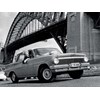
.jpg)
.jpg)
.jpg)
.jpg)
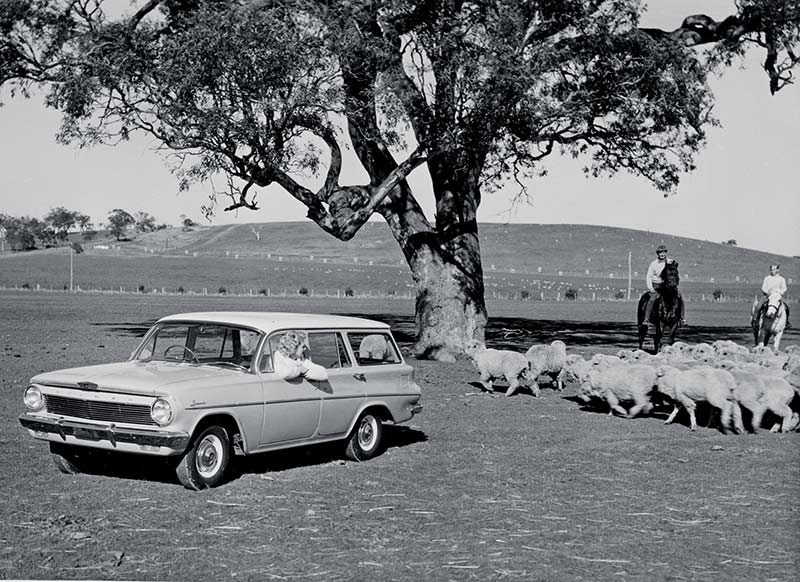

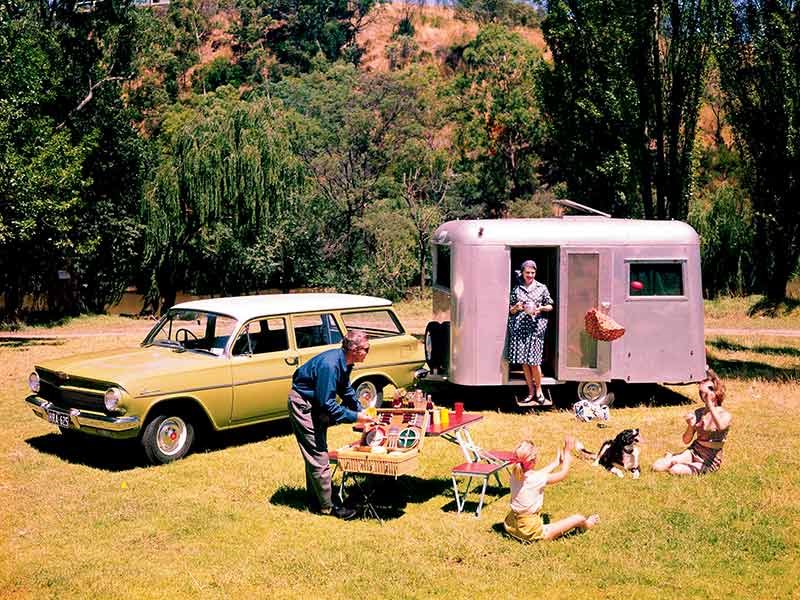

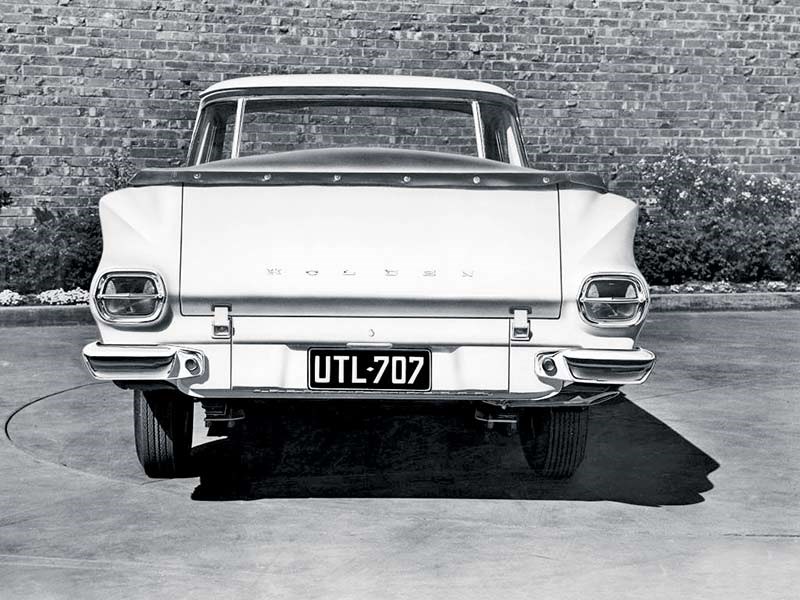

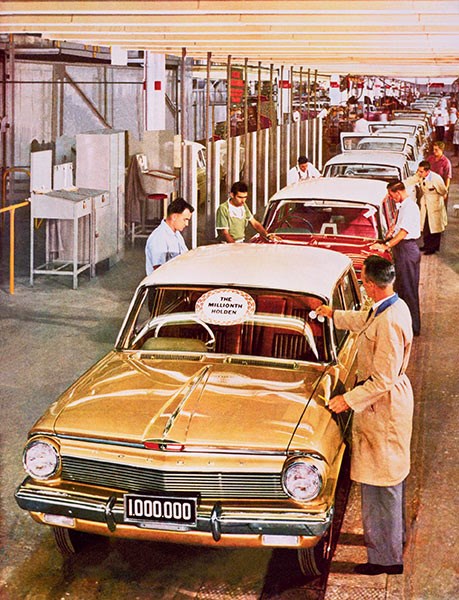

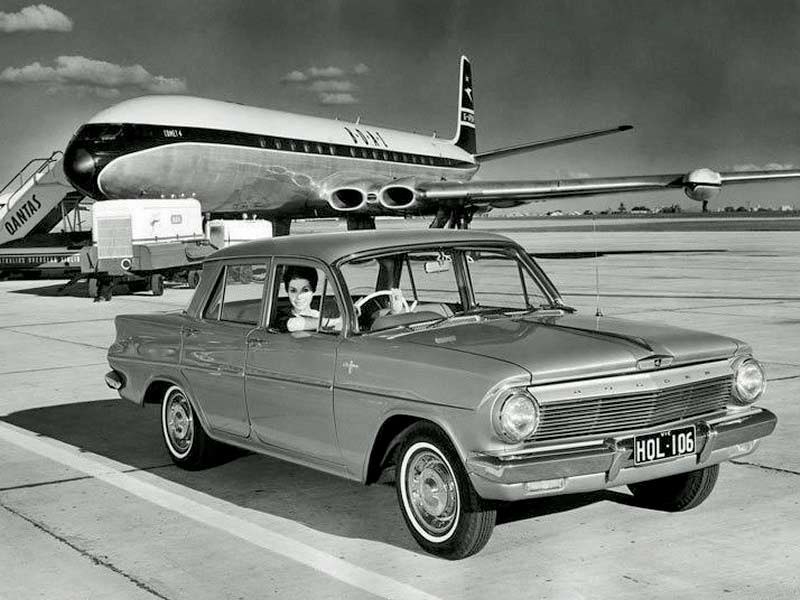


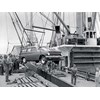
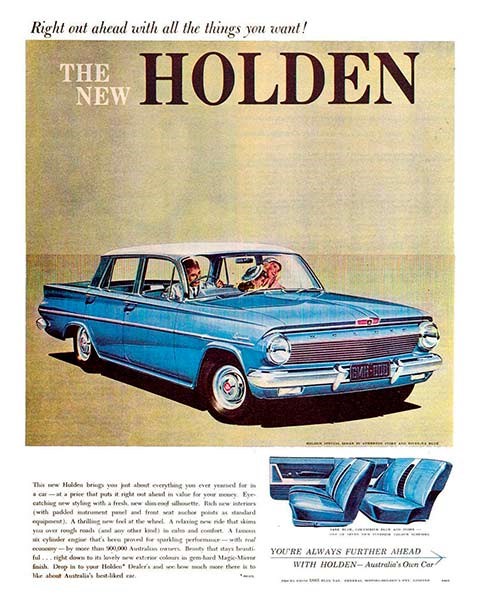

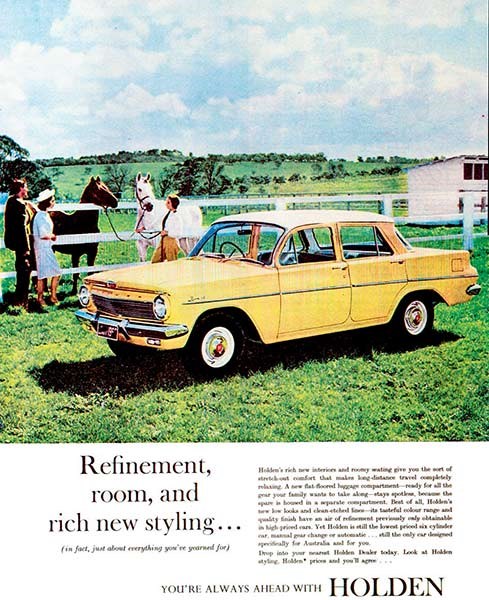

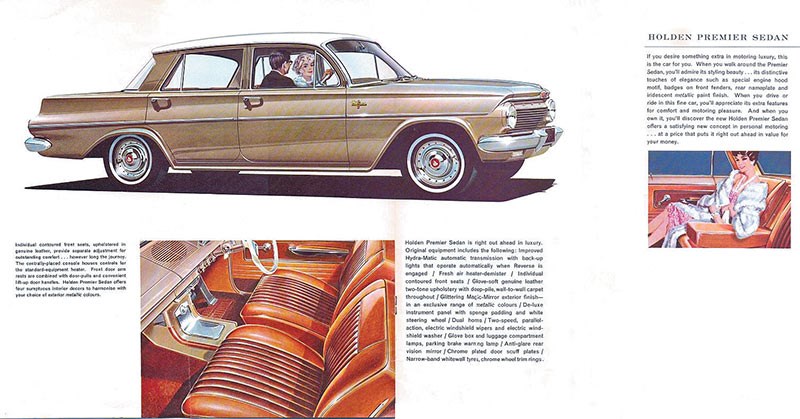


|
.jpg)
|
.jpg)
|

|

|

|

|

|

|

|

|

|
Never underestimate the Toorak factor, especially in 1962, says John Wright
EJ Holden
In hindsight, GMH’s product planning of the 1962 Holden EJ Premier seems even wackier now than it did at the time. With its front bucket seats, Howe leather trim, thin-band whitewall tyres and Mercedes-like white steering wheel, the Premier brought luxury to Australia’s Own Car for the first time. The wacky bit was that this significantly heavier variant was offered only with power-sapping Hydra-Matic transmission.
Did this prove that Holden’s product planners did not grasp what automotive luxury entailed? Did it mean they were more inspired by, say, the Humber Hawk than the Jaguar Mark 2? By the time the first Premier was conceived, even such conservative English manufacturers as Armstrong-Siddeley, Daimler and Rover had either grasped – or were about to grasp, the year being 1959 or 1960 – that respectable, if not outstanding, performance was a critical ingredient in the luxury car recipe.
Interestingly, Ford Australia launched its XL Falcon range in the same week and it included a ‘luxury’ Futura variant. The Falcon already had an optional ‘Pursuit’ engine with 101 brake horsepower, 11 more than the standard unit. Futura buyers could choose any combination: small-engined manual, small-engined auto, Pursuit manual or Pursuit auto.

The oddness of the EJ Premier is best understood by contrasting it with the original 48-215 Holden sedan. That car offered 60 brake horsepower and weighed 2200 lb. After the flipping over all of nearly 14 desk calendars, the EJ Premier had 75 brake horsepower but weighed 2639 lb. Politely (this was 1962 and journalists wore ties to work, imagine!), Wheels magazine’s tester wrote: ‘Because of its extra weight, compared with the Holden standard and special models, and its compulsory automatic gearbox, the Premier does not give a sensational performance…I could not top 80 mph, and acceleration times were just adequate, certainly not exciting.’ The 48-215 could reach 60 mph from a standing start in 12 seconds, the EJ Premier took 13.5.
Of course the new ‘red’ engines were still in the final stages of development in July 1962 but it does seem strange that no effort was made to maximise the performance of the ‘grey’ (‘the old grey mare, she ain’t what she used to be’) engine for this application. After all, by the mid-1950s the reality of 100 mph Holden hotrods had arrived. The idea of producing a more prestigious version of a mainstream sedan was not new.
Ford was first with the Zephyr Zodiac in the European autumn of 1953. Essentially, Holden aped the Zodiac specification except for one of the main elements. Ford’s engineers had raised the engine’s compression ratio from 6.8:1 to 7.5 for an increase of three brake horsepower. Yes, you could argue that this was more symbolic than anything else but Holden could easily have chosen this path. A modified cylinder head was all that would have been needed. And could it really have been that difficult to develop an all-synchromesh version of the manual gearbox just for the Premier?
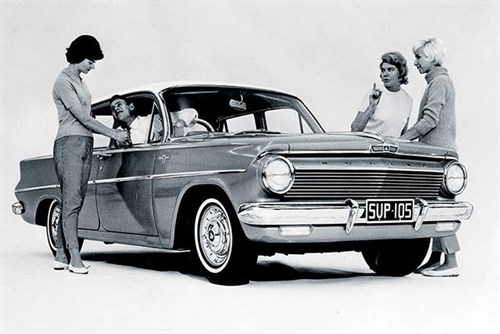
It all smacks of complacency. The probability is that Holden’s product planners decided that an up-spec version of the new shape Holden would satisfy the demands of an increasingly affluent car-buying market and help add interest to the EJ until the new engines were ready the following year. (There was certainly interest when rumours circulated from suppliers about bucket seats ordered by GMH: what punters predicted was not a Holden luxury model but a sports car!) Notwithstanding its mediocre performance, the Premier sold strongly but at least some customers didn’t stay happy for long.
A fellow Holden historian is about to launch his sixth book on early model Holdens and the people who love them. The fifth tome, Holden Days, contains a tale of one Holden lover who owned his brand new EJ Premier for a very short time.
‘During only my sixth week of ownership, while driving into the Melbourne CBD, I caught up with a new car, the back of the just released EH Holden. ‘Now that’s what the back of mine should look like,’ I said. I followed it to Preston Motors, the Holden dealer where I’d bought my EJ. New EH sedans on the showroom floor struck me as perfect in appearance. When told that the new 179 motor had so much more power than my EJ, I could no longer live with my recent purchase!
So there and then I signed up for a metallic light blue with cream top Premier.’
While many enthusiasts love the distinctive, almost complex styling of the EJ, history suggests that for the majority, the EH solved nearly all the problems of its predecessor.
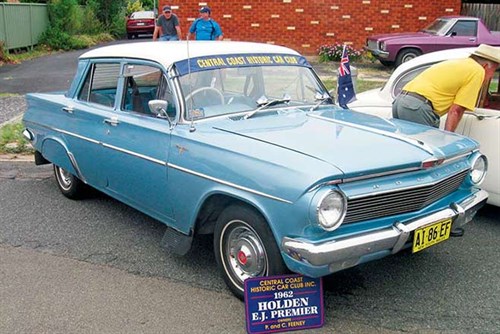
Obviously the decision not to offer a manual version was quickly recognised as a mistake because the EH Premier was available in this guise as soon as the engineers had beefed up the gearbox (a few months after the model’s August 1963 debut).
There’s a fascinating story behind the EH facelift and, indeed, behind the final production-ready version of the EJ. Interviewing Joe Schemansky, Holden’s first director of design staff in 1964, for Wheels in the mid-80s he told this story. Walking through a styling studio one day, one shape caught his eye. ‘Even without lifting the cover I could see there was something very odd about it. I lifted the cover and correctly guessed that the car was a Holden. "This is awful," I said to [fellow designer] Paul [Gillan]. "Bill Mitchell ought to see this."’
Mitchell, who had just replaced Harley Earl as GM’s chief designer, agreed and ordered a quick rework. Peter Nankervis, an Australian stylist, told me years ago: ‘They picked up the bumpers, put valances underneath, made a clean radiator with a "forehead" and gave it a reverse angle grille with very fine blades.’ The car that Modern Motor magazine had scooped for the cover of its April 1961 edition was what Nankervis described as ‘the early version… not a nice looking car, particularly in that revolting shade of green on the cover of the magazine.’
Improved the EJ might have been, but Mitchell’s team did not want to take any more risks with Australian designers. Both the EH facelift and the all-new HD were done in Detroit and arrived at Fishermans Bend in boxes.
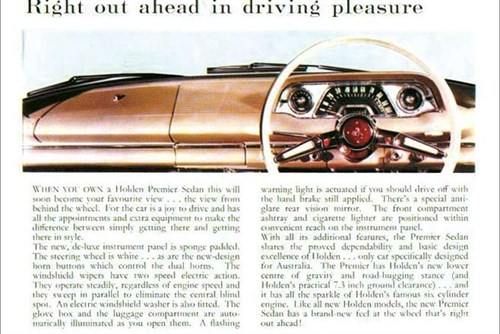
Although the faster and – to most people – more attractive EH has overshadowed the EJ in the history of Holden, the EJ Premier remains a landmark model. In terms of its fittings and finish it really was an Australian alternative to a Mercedes-Benz 220SE or even a Jaguar Mark 2 and at a much lower price. Critics had long carped on about the lack of a heater or carpet in the Holden Special (what, then, they might have asked is so ‘special’ about it?). But the Premier’s elaborate heater-demister and wool-pile carpet were among the best to be found anywhere in 1962. And the Howe leather used on the front bucket seats (which, incidentally, were designed by Ray Herring, who had come to Holden from Ford, where he had worked with Lew Bandt on the first utility in the very early 1930s!) was at least the equal of a Jaguar’s. As for the 220SE, it used a high grade vinyl similar to the HD Premier’s ‘Morrokide’ (but how anyone could prefer even the finest vinyl to leather was beyond me in 1962 and is beyond me now).
The colour schemes, too, were inspirational. Metallic paint was still quite new to Australia in 1962 and the EJ Premier’s mostly two-tone combinations with contrasting interiors made the heavy-handed two-toning or even triple-toning of the 1959 Star Model Customline look old-fashioned and garish. Typically, an elegant colour like Wimmera Green, Theatre Grey or Euroa Gold (the colour of the millionth Holden which made its way down the Fishermans Bend line on 25 October 1962) – was used for the lower sections of the car with the roof in Atherton Ivory. Interiors also used two colours in red (Astoria and Waldorf Red), brown (Samoan Tan and Vaucluse Brown), blue (Merle and Pagoda Blue) or green (Akron and Vagabond Green). To find anything approaching such imaginative yet tasteful combinations in a contemporary car, it will need to be very much further upmarket than the EJ Premier was in its brief heyday.
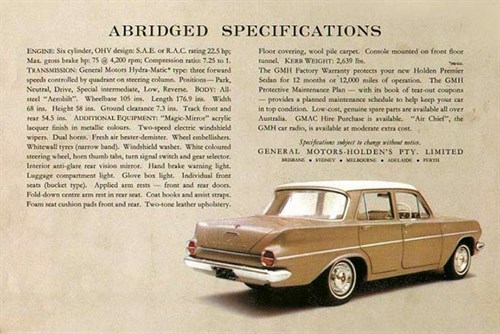
Although the EH would prove to be the better car, that is hardly the point. The EJ Prem represented a kind of coming of age. Think of a high school girl preparing for her first dance. The EJ was easily the prettiest Holden to date; the Premier was almost beautiful. (I’ll have mine in Wimmera Green metallic, please.)
There was a paradox at the heart of the car which went like this. Given the Holden had always been seen as lowly but honest, a luxurious version was, by definition, an exclusive machine, almost more so than, say, any old ‘Auntie’ Rover.
So, despite its relatively poor performance, the EJ Premier was well targeted as a second car to affluent families in suburbs like Toorak and Vaucluse. If Mother was on her outing to the bridge club, she was unlikely to be worried about modest acceleration, while Father could always compare his Jaguar Mark Ten favourably with his wife’s Premier. Even though the Premier was conceived before the suits at GMH had any idea what kind of car the Zephyr Mark III was going to be, in some ways it blunted the potential challenge by the radical new Ford with its high performance, four-speed all-synchromesh gearbox, and front disc brakes. Because the Zephyr was in some respects a stripper, closer in interior equipment levels to a common or garden Holden Special, it did not achieve the status it deserved.
No question, the EJ Premier was a great success and it was one of those cars that prove how, on occasion, motoring journalists can misunderstand the public’s taste.
Unique Cars magazine Value Guides
Sell your car for free right here
Get your monthly fix of news, reviews and stories on the greatest cars and minds in the automotive world.
Subscribe

.jpg)









.png)



